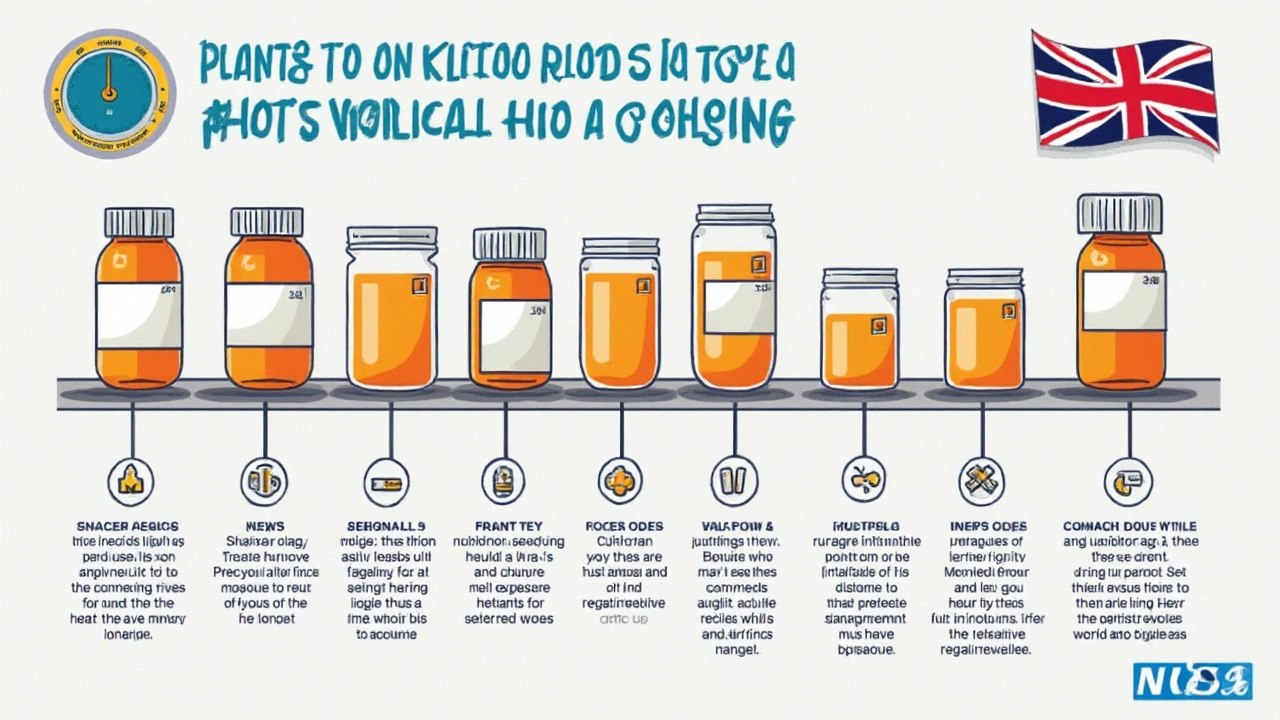Hypertension meds aren’t one-size-fits-all. Maybe Lisinopril's giving you a cough that keeps you or your partner up at night. Or maybe your lab results show weird potassium numbers that have your doc raising an eyebrow. Good news: you’ve got plenty of options, even if Lisinopril isn’t your jam.
This guide unpacks ten real alternatives, not just from a textbook, but with honest pros and cons. Tired of side effects like swollen ankles or dizzy spells? Want something that won’t interfere with your other meds? We’ll break down what each med actually does, how it stacks up against Lisinopril, and which is best for different situations. Ready to sort your choices and talk with your doctor like you actually know what’s up? Let’s get into it.
- Amlodipine
- Losartan
- Hydrochlorothiazide
- Atenolol
- Valsartan
- Metoprolol
- Enalapril
- Diltiazem
- Aliskiren
- Spironolactone
- Comparing Your Options
Amlodipine
When you're looking for Lisinopril alternatives, amlodipine jumps off the page. It's a pretty popular pick—actually, it's one of the most prescribed blood pressure meds in the world. Amlodipine belongs to a group called calcium channel blockers (you might hear your doctor say "CCB"). What does that mean for you? Basically, it helps relax your blood vessels, so your heart doesn't have to work as hard to pump blood around your body.
People like amlodipine because it doesn't mess with your potassium levels. Unlike Lisinopril, you don't have to stress over lab results showing high or low potassium. For folks with stubborn high blood pressure, especially older adults with what doctors call "isolated systolic hypertension," amlodipine is often first-line. It's even nice if you can't handle ACE inhibitors—no annoying cough to worry about here.
Still, it's not perfect. Swollen ankles ("peripheral edema" if you want the medical lingo) can be a thing—my mom had to size up her shoes when she started it. It's also not the best call if you’ve got heart failure. But most people tolerate it just fine for basic blood pressure control.
"Amlodipine is effective, generally well-tolerated, and favorable for blood pressure management, especially in older adults." — American Heart Association Hypertension Guidelines, 2023
If you want to see how often side effects pop up, here's what researchers found:
| Common Side Effect | How Often (%) |
|---|---|
| Swelling (Edema) | 5-10% |
| Dizziness | 2-4% |
| Headache | 3-6% |
Pros
- No impact on your potassium levels—no weird lab surprises
- Works well for isolated systolic hypertension (common in folks over 60)
- Zero risk of the dry cough that can hit with Lisinopril
- Taken once a day—easy to remember
Cons
- Can cause ankle and foot swelling
- Not for people with heart failure
- Rarely, can lower blood pressure too much—watch for dizziness, especially if you stand up quickly
Losartan
Losartan is a template swap when Lisinopril isn’t cutting it or you just can’t handle that stubborn cough. It’s an ARB—angiotensin II receptor blocker—so it still targets the same blood pressure system as Lisinopril but from a different angle. It blocks a hormone that tightens your blood vessels, keeping things relaxed and your numbers down.
Most folks notice it’s easier on side effects, especially with that annoying dry cough or facial swelling that sometimes pops up with ACE inhibitors like Lisinopril. If you have kidney issues, especially from diabetes, Losartan is often preferred because it helps protect your kidneys. In fact, docs like to reach for Losartan for people with diabetic nephropathy.
If you’re switching from Lisinopril alternatives, you’ll still need regular bloodwork. Losartan can nudge potassium up, but usually less so than an ACE inhibitor. Whether you’re already taking meds for arthritis or gout, Losartan usually plays nice, with less risk of raising uric acid levels (a win if you hate gout flare-ups).
Pros
- Rarely causes a cough—huge bonus for anyone sick of hacking through the day
- Great for people with diabetes or early kidney disease
- Typically well-tolerated, even for older adults
- Lower risk of angioedema (facial/tongue swelling) than Lisinopril
- May lower uric acid—sometimes used when gout is a problem
Cons
- Still need to watch potassium levels, just not quite as much as with Lisinopril
- May not be as potent in certain types of heart failure
- Can interact with some anti-inflammatory meds
- It’s not for pregnancy—can cause serious harm to unborn babies
| Key Comparison | Losartan | Lisinopril |
|---|---|---|
| Cough | Rare | Common |
| Protects Kidneys | Yes | Yes |
| Angioedema Risk | Lower | Higher |
| Potassium Issues | Mild | Moderate |
If you’re juggling both blood pressure medications and some other chronic issues, Losartan is a solid, flexible pick. Definitely worth a conversation with your doctor, especially if Lisinopril has started causing more trouble than it’s worth.
Hydrochlorothiazide
Hydrochlorothiazide, or HCTZ for short, is one of the most prescribed blood pressure meds out there. Think of it as the go-to "water pill" that doctors reach for when someone with hypertension needs to drop their numbers and maybe lose some extra fluid. It’s not just about blood pressure, though; it also helps with swelling from heart or kidney issues.
What makes Hydrochlorothiazide stand out from Lisinopril alternatives is the way it works—it tells your kidneys to get rid of extra salt and water. Less fluid in your blood vessels means less pressure on the walls. Simple, but effective.
“Thiazide diuretics, like hydrochlorothiazide, are a cornerstone of hypertension treatment and are often recommended as first-line therapy for most adults.”
— American Heart Association
HCTZ has been around forever, so doctors know it well. It’s cheap and you can find it just about everywhere. One big thing: it doesn’t affect potassium in the same direction as Lisinopril. In fact, it can actually drop potassium and sodium, so docs sometimes monitor your blood tests and may suggest bananas, potatoes, or even a supplement.
Pros
- Works fast and lowers blood pressure effectively
- Reduces swelling (edema) from different causes
- Cheap and widely available as a generic
- Well-studied and understood by healthcare providers
Cons
- Can lower potassium and sodium, causing muscle cramps or weakness
- Might raise blood sugar and uric acid (not ideal for diabetics or people with gout)
- May make you pee more, especially when you first start it
- Not the top pick for people with kidney problems
| Fact | Data |
|---|---|
| Typical starting dose | 12.5–25 mg daily |
| Common side effect | Increased urination |
| Average price (generic, USA) | $5–$10/month |
So if a doc hands you a prescription for HCTZ instead of Lisinopril, it’s nothing unusual. Just make sure to check in on your bloodwork, especially in the first few months, and mention if you feel extra tired or have leg cramps. Stay hydrated, but don’t go overboard—and keep an eye out for extra snack cravings if you’re losing more potassium.
Atenolol
If you’re searching for Lisinopril alternatives, Atenolol is a name you’ll definitely hear. It’s a beta-blocker, which means it slows your heart rate and reduces how hard your heart needs to work. It’s been around since the 1970s, and it’s still widely prescribed globally.
Atenolol is often used for both high blood pressure (hypertension) and heart problems like chest pain (angina) or after heart attacks. Unlike some other blood pressure meds, it’s also a favorite when the goal is to keep your heart rate in check—so it does double duty for people who need extra heart protection.
One interesting thing about Atenolol: it doesn’t cross the blood-brain barrier very well, so it tends to have fewer mood or sleep side effects compared to older beta-blockers like propranolol. That’s why docs sometimes choose it if you’ve had issues with nightmares or weird dreams from other meds.
If you’ve got a history of asthma or breathing issues, though, Atenolol usually isn’t first choice because it can make symptoms worse. And, like all beta-blockers, you need to avoid suddenly stopping it—quitting cold turkey can actually be risky for your heart.
Pros
- Great for people with both hypertension and heart problems
- Reduces risk of repeat heart attacks
- Doesn’t usually cause the persistent cough you get with ACE inhibitors like Lisinopril
- Less likely than older beta-blockers to cause sleep problems
Cons
- Not ideal for folks with asthma or chronic lung disease
- Can cause slower heart rate and sometimes fatigue
- May affect blood sugar control—if you have diabetes, your doc will keep a close eye
- Can mask early signs of low blood sugar in diabetics
- Stopping suddenly can be dangerous
Here’s a look at how Atenolol compares to other Lisinopril alternatives on some key points:
| Medication | Useful For | Main Watch-out |
|---|---|---|
| Atenolol | Blood pressure + heart protection | Not for asthma, careful with diabetes |
| Lisinopril | Blood pressure + kidney protection | Cough, potassium issues |
If you’re on Atenolol, bringing up any heart symptoms, fatigue, or even changes in how you’re exercising is worth a chat with your doctor. They can adjust your dose or suggest another one of the many blood pressure treatment alternatives.
Valsartan
If Lisinopril isn’t working out, Valsartan could be a solid backup. It’s part of the angiotensin II receptor blocker (ARB) family, which means it blocks a hormone that tightens your blood vessels—helping them relax and drop your blood pressure. Docs often pick it for people who can’t handle the nagging dry cough that Lisinopril (an ACE inhibitor) often brings on. Valsartan skips that side effect, making life a bit quieter at night.
There’s more: Valsartan’s also handy for people with heart failure or those who’ve had a recent heart attack. Unlike some other meds, it doesn’t usually mess with your potassium levels as much, though your doc will probably still keep an eye on them just in case.
Pros
- Doesn’t usually cause the dry cough that comes with Lisinopril
- Often used for heart failure and after heart attacks
- Doesn’t tend to impact potassium as much as ACE inhibitors
- Well-tolerated by people who can’t take ACE inhibitors
Cons
- Can still cause dizziness, especially when starting out
- Rarely, may raise potassium or lower kidney function—labs are still important
- Not recommended during pregnancy
- Costs more than some generic ACE inhibitors
Just for perspective, check out how Valsartan stacks up against Lisinopril and another common ARB, Losartan:
| Medication | Drug Class | Common Side Effect | Special Use |
|---|---|---|---|
| Lisinopril | ACE inhibitor | Dry cough | Post-heart attack, kidney protection |
| Valsartan | ARB | Dizziness | Heart failure, post-heart attack |
| Losartan | ARB | Dizziness | Diabetic kidney protection |
If you want a medication that avoids the ACE inhibitor cough but still handles hypertension and protects your heart, Valsartan is definitely worth asking about at your next appointment.

Metoprolol
Metoprolol is a beta-blocker that’s been around for decades. When it comes to Lisinopril alternatives, this one stands out for people who have both high blood pressure and heart problems, like a history of heart attack or certain types of arrhythmias. Instead of relaxing your blood vessels directly like Lisinopril or amlodipine, metoprolol mainly slows down the heart rate and makes it pump with less force. So, blood pressure drops, and the heart doesn’t have to work as hard.
Doctors usually turn to metoprolol if you’ve had issues like a past heart attack, angina, or you’re dealing with a fast or irregular heartbeat. It’s also a solid pick if you need something that won’t hike up your potassium levels—Lisinopril sometimes can.
Pros
- Great for people with a history of heart attacks or angina
- Helps control irregular and fast heartbeats
- Doesn’t usually mess with your potassium
- Widely available as a generic and often covered by insurance
Cons
- Might cause fatigue or make you feel low on energy
- Can worsen asthma or other breathing conditions
- Some people notice cold hands and feet
- Not a good first pick if you only have high blood pressure and no other heart issues
Fun fact: A big clinical trial called the MERIT-HF study showed that metoprolol can lower the risk of death in people with heart failure. But on the flip side, beta-blockers like metoprolol aren’t ideal for everyone. If you’re active and like running around with kids or hitting the gym, you might feel like you’ve lost a bit of pep—this med can slow you down.
| Who It's Best For | Main Uses | Watch Out For |
|---|---|---|
| Heart attack survivors, arrhythmia patients, folks with migraines | Lowering high blood pressure, protecting the heart, rhythm control | Fatigue, possible shortness of breath, not for severe asthma/COPD |
If you’ve got both hypertension and you’re watching your heart health, metoprolol can be a double win. Just make sure to check in with your provider about any breathing problems or if your energy tanks after starting it.
Enalapril
Enalapril is another ACE inhibitor, just like Lisinopril. Doctors often pick it when someone isn’t handling Lisinopril well, or needs a little flexibility in dosing. It's been around for decades and has built a solid rep for treating high blood pressure and heart failure. If you’re after a drug with a proven track record and the option to go from pills to a liquid (good for folks who can’t swallow tablets), Enalapril is worth talking about.
This med works by relaxing your blood vessels, which helps lower blood pressure and makes it easier for your heart to pump. It's pretty common in both younger adults and seniors, and doctors usually start with a low dose and tweak as needed.
Pros
- Long history of use—trusted by heart docs for years
- Available as a tablet and a liquid (great for older adults or kids with swallowing issues)
- Flexible dosing options for different body sizes and kidney function
- Helps lower the risk of stroke, heart attack, and kidney issues from high blood pressure
Cons
- Can cause that classic ACE inhibitor dry cough—just like Lisinopril
- Might bump up potassium levels, so folks with kidney problems need close monitoring
- Less effective for African-American patients unless combined with other blood pressure meds
- Not safe during pregnancy—should be switched out if you’re planning to have a baby
According to real-world studies, Enalapril lowers blood pressure on average by about 10-15 mmHg systolic (top number), which puts it right on par with many other Lisinopril alternatives. Most people notice results in 2-4 weeks, but your doc may adjust the dose until your numbers are in the safe zone.
Diltiazem
Diltiazem is a standout option if you want a blood pressure med that isn't an ACE inhibitor like Lisinopril. This one falls in the category of calcium channel blockers, but it's a little different from the more common dihydropyridines (like amlodipine). Diltiazem works by slowing down the way your heart squeezes and relaxes, which lowers your blood pressure and eases the workload on your heart. So, if you have both hypertension and something like atrial fibrillation or fast heart rhythm, doctors might pick diltiazem over other options.
Unlike some other blood pressure drugs, diltiazem can also help with chest pain (angina). That’s a plus if you get tightness in your chest after running up stairs or chasing your kids (let’s be real—parent life, right?). What’s cool is that diltiazem doesn’t usually mess with potassium and doesn’t make you cough the way some people get with Lisinopril.
Pros
- Can lower blood pressure and slow heart rate at the same time
- Helpful for atrial fibrillation or other fast heart rhythms
- Rarely causes cough or affects potassium like Lisinopril alternatives
- Can treat angina (chest pain from poor blood flow)
- Less likely to cause swollen ankles compared to some other calcium channel blockers
Cons
- Not great for people with heart failure (could make symptoms worse)
- Might cause constipation or stomach issues
- If you’re an athlete or have a low heart rate, watch out—it can slow your pulse too much
- Can interact with some other medicines like beta-blockers or certain statins
Here’s a quick look at how diltiazem stacks up against other common blood pressure meds:
| Drug | Heart Rate Effect | Potassium Effect | Cough Risk | Good for Angina? |
|---|---|---|---|---|
| Diltiazem | Slows it | No effect | Rare | Yes |
| Lisinopril | No effect | Can raise | Common | No |
| Amlodipine | No effect | No effect | Rare | Yes |
So if your main problem is not just blood pressure, but heart rhythm or chest pain too, diltiazem could be worth a real conversation with your doc. It’s not perfect—nothing is—but in the right situation, it brings a lot to the table without the classic Lisinopril side effects.
Aliskiren
If you’re checking out Lisinopril alternatives, Aliskiren might pop up as something pretty different. It’s a direct renin inhibitor, which means it blocks renin—the stuff your kidneys release that helps bump up blood pressure. By targeting this first step in the chain reaction, Aliskiren can lower blood pressure from a different angle than ACE inhibitors (like Lisinopril) or ARBs (like Losartan).
Doctors usually try Aliskiren when folks haven’t done well with other drugs or have had nagging side effects. It’s not the go-to starter pill, but it’s FDA-approved for high blood pressure in adults. It works either alone or with other meds, making it flexible if your numbers are stubborn or you’re trying to avoid that annoying ACE inhibitor cough.
Pros
- No cough, unlike Lisinopril. That’s a relief for anyone who’s lost sleep (or their spouse’s patience) over it.
- Blocks blood pressure increases early in the process—sometimes leads to consistent readings over time.
- Can be used if you can’t tolerate both ACE inhibitors and ARBs.
- OK as a solo therapy or paired up with another blood pressure medication for a bigger punch.
Cons
- Higher price tag compared to older meds like Lisinopril or Hydrochlorothiazide.
- May cause diarrhea—yeah, not fun.
- Don’t use it with ACE inhibitors or ARBs—can lead to serious kidney or potassium troubles, especially in anyone with diabetes.
- Doesn’t have a long safety track record like some older options.
If you’re younger and generally healthy but struggle with side effects from typical choices, your doctor might bring up Aliskiren. You’ll usually start with 150 mg daily, and it can be boosted to 300 mg if you need stronger results. Heads-up: Taking this med with a high-fat meal can lower how much your body absorbs, so best to pop it before you eat, or stick with light snacks.
| Usual Starting Dose | Max Dose |
|---|---|
| 150 mg by mouth daily | 300 mg by mouth daily |
Last thing—pregnant women should avoid this one. It’s known to cause serious harm to unborn babies. And if you have kidney troubles or diabetes, make sure your doc is in the loop because this isn’t always a safe pick. But if you’re out of luck with other options, Aliskiren just might be the move you need.
Spironolactone
Spironolactone isn’t your average blood pressure pill. It’s a potassium-sparing diuretic, which basically means it helps your body get rid of extra salt and water, but hangs onto potassium. For folks dealing with high blood pressure and also struggling with low potassium or some types of heart failure, this can be a real game changer. If you’ve got heavy legs, puffy ankles, or you’ve heard the words “aldosterone antagonist” tossed around, this is probably the drug your doctor has in mind.
Here’s the kicker—Spironolactone goes beyond just blood pressure. Doctors often use it to treat things like heart failure, swelling from liver disease, or sometimes even stubborn acne. But for hypertension, it’s usually added when other meds like Lisinopril, diuretics, or calcium channel blockers aren’t pulling their weight.
"Spironolactone has become an important tool in resistant hypertension—that’s high blood pressure not controlled by standard medication combos." – American Heart Association
Pros
- Doesn’t lower potassium—can actually raise it (helpful if you run low)
- Helps reduce swelling and can even help with certain heart issues
- Useful for people whose blood pressure doesn’t budge with common meds
- May improve survival in some heart failure patients—proven in studies
Cons
- Can cause too much potassium (hyperkalemia), which can be dangerous
- Might lead to breast tenderness or swelling in men (yes, it happens)
- Frequent blood tests are a must to check potassium and kidney health
- Not a first pick if you already have kidney trouble
| Lab Test | Expected Change |
|---|---|
| Potassium | Increase |
| Sodium | Decrease |
| Creatinine | Possible increase (watch kidneys!) |
It’s always smart to chat with your healthcare provider about the reasons to pick Spironolactone over other Lisinopril alternatives. You’ll probably get bloodwork every few weeks at first just to make sure everything stays in the safe zone. But for people with the right needs, it’s a heavy hitter in the blood pressure world.

Comparing Your Options
Trying to pick between blood pressure meds can feel crazy complicated. There’s no single best answer—what works for your uncle or neighbor might totally flop for you. Still, you’re not stuck guessing. Here’s a side-by-side look at the alternatives to Lisinopril alternatives we’ve talked about. This makes it way easier to figure out what matches up with your health needs, especially if things like cough, swollen ankles, or weird bloodwork have been a problem in the past.
| Medication | Main Type | Good For | Watch Out For |
|---|---|---|---|
| Amlodipine | Calcium Channel Blocker | Isolated systolic hypertension, people sensitive to potassium swings | Swelling in feet/ankles |
| Losartan | ARB | ACE cough, diabetics with protein in urine | May raise potassium, avoid in pregnancy |
| Hydrochlorothiazide | Thiazide Diuretic | Older adults, mild blood pressure bumps | Low potassium, can make gout worse |
| Atenolol | Beta Blocker | People with heart disease, post-heart attack | Can slow heart too much, not awesome for asthma |
| Valsartan | ARB | Similar to Losartan, kidney protection | Same potassium issues as Losartan |
| Metoprolol | Beta Blocker | Heart failure, post-heart attack patients | Low heart rate, fatigue |
| Enalapril | ACE Inhibitor | Similar to Lisinopril, kidney protection | Dry cough, can increase potassium |
| Diltiazem | Non-Dihydropyridine Calcium Channel Blocker | Rate control in AFib, hypertension | Slow heart rate, avoid in heart failure |
| Aliskiren | Direct Renin Inhibitor | ACE/ARB intolerant patients | Diarrhea, avoid in diabetes and kidney disease |
| Spironolactone | Aldosterone Antagonist | Resistant hypertension, heart failure | Man boobs in men, high potassium |
Choosing the right alternative to Lisinopril depends on what you’re actually dealing with. If you get low potassium, Amlodipine might make more sense. If your blood pressure just refuses to budge, Spironolactone is sometimes a lifesaver. Got diabetes and protein in your pee? Your doc may prefer an ARB like Losartan. Each med has its own quirks and side effects—sure, some cause swelling, others mess with heart rate or your labs—so being upfront about your health history helps a ton.
Don’t be shy about asking your doctor about these alternatives. Bring up this chart at your next visit, and use those keywords like blood pressure medications and hypertension. Trust me, your doctor will appreciate you coming prepared.





People act like any med will do as long as the pressure drops, but they forget the human side of it. Lisinopril may give you a cough, yet you’re expected to just swallow it without question. Doctors love to toss a pill and move on, ignoring how it messes with sleep and daily life. It’s not just about numbers; it’s about quality of living. If a drug makes you cough all night, speak up and demand something that respects your comfort.
Indeed, the pharmacodynamic profile of each alternative warrants a nuanced discussion. Amlodipine, for instance, offers calcium‑channel blockade without impacting the renin‑angiotensin system, thereby sidestepping ACE‑inhibitor cough while introducing peripheral edema in a subset of patients. Losartan’s angiotensin II receptor antagonism preserves glomerular filtration, making it advantageous for diabetic nephropathy, yet it still necessitates periodic serum potassium surveillance. Hydrochlorothiazide’s thiazide diuretic mechanism efficiently reduces plasma volume, though clinicians must monitor glycemic indices due to its potential to exacerbate hyperglycemia. Beta‑blockers such as atenolol and metoprolol provide cardioprotective effects post‑myocardial infarction, but their negative chronotropic action can precipitate fatigue and bronchospasm in asthmatic individuals. In contrast, diltiazem’s non‑dihydropyridine class modulates both vascular tone and cardiac conduction, serving dual purposes in hypertension and rate control for atrial fibrillation. The clinician’s task is to align the pharmacologic attributes with the patient’s comorbid landscape, ensuring that the chosen regimen optimally balances efficacy and tolerability.
The real culprit is the globalist pharma cartel pushing these drugs on unsuspecting citizens.
While the notion of a monolithic cartel is rhetorically potent, the reality of drug development involves rigorous regulatory oversight and multifaceted clinical evidence. Each medication listed has undergone phase‑III trials demonstrating safety and efficacy within defined populations. It’s essential to separate legitimate concerns about side‑effects from conspiratorial narratives. A balanced perspective encourages patients to discuss alternatives with their healthcare providers rather than retreating into fatalism.
Dear readers, I wish to respectfully underscore the importance of individualized therapy in hypertension management. The array of pharmacologic classes presented offers clinicians the latitude to tailor treatment according to renal function, comorbidities, and patient preference. While calcium‑channel blockers such as amlodipine are commendable for isolated systolic hypertension, one must vigilantly monitor for peripheral edema. ARBs like losartan provide renal protection in diabetic patients, yet serum potassium remains a pertinent laboratory parameter. Thiazide diuretics, though cost‑effective, may precipitate hypokalemia and exacerbate gout. In every case, shared decision‑making between physician and patient serves as the cornerstone of optimal outcomes.
Thank you for the thorough overview. I’d add that many patients benefit from a combination approach-often a low‑dose ACE inhibitor with a thiazide can mitigate each other’s side‑effects. Education on diet, especially potassium‑rich foods when on diuretics, empowers patients to avoid electrolyte imbalances. Monitoring blood pressure at home also helps fine‑tune dosing between visits. Ultimately, the goal is a regimen that the patient can adhere to without compromising quality of life.
Just a quick note: if you’re switching meds, give your body a couple of weeks to adjust before adding another. Some people notice a dip in energy when starting a beta‑blocker, so watch how you feel.
Good point, patience is key. Stay aware of any new symptoms.
When evaluating alternatives to lisinopril, it is helpful to categorize them by their mechanistic class and clinical context. Calcium‑channel blockers, such as amlodipine and diltiazem, reduce systemic vascular resistance by inhibiting L‑type calcium channels in vascular smooth muscle. Amlodipine, a dihydropyridine, is particularly effective for isolated systolic hypertension seen in older adults, but clinicians must counsel patients about the potential for peripheral edema, which occurs in approximately 5‑10 % of users. Diltiazem, a non‑dihydropyridine, exerts both vasodilatory and negative chronotropic effects, making it suitable for patients with concomitant atrial fibrillation or angina, yet it is contraindicated in severe heart failure due to its negative inotropic properties.
Angiotensin‑II receptor blockers (ARBs) such as losartan and valsartan selectively block the AT₁ receptor, attenuating the vasoconstrictive and aldosterone‑secreting actions of angiotensin II. These agents are advantageous for patients intolerant to ACE inhibitors because they rarely provoke a dry cough. However, they can still cause modest elevations in serum potassium and should be avoided in pregnancy. Losartan possesses an additional benefit of lowering uric acid levels, which can be protective in gout‑prone individuals, whereas valsartan is often selected for its robust evidence in post‑myocardial infarction remodeling.
Thiazide diuretics, epitomized by hydrochlorothiazide, decrease extracellular fluid volume by inhibiting Na⁺/Cl⁻ reabsorption in the distal convoluted tubule. They are inexpensive and effective for modest hypertension, yet they may induce hypokalemia, hyperglycemia, and hyperuricemia, necessitating periodic laboratory monitoring. In patients with diabetes or gout, clinicians sometimes prefer a potassium‑sparing diuretic or combine a thiazide with an ACE inhibitor to mitigate electrolyte disturbances.
Beta‑blockers, exemplified by atenolol and metoprolol, blunt sympathetic outflow by antagonizing β₁‑adrenergic receptors, reducing heart rate and myocardial contractility. These agents are first‑line for hypertension with concurrent coronary artery disease or after myocardial infarction. Atenolol’s limited central nervous system penetration reduces the incidence of nightmares compared with propranolol, but both drugs can exacerbate bronchospasm in asthmatic patients and mask hypoglycemia in diabetics. Metoprolol, especially in its extended‑release formulation, offers greater titration flexibility and is favored in heart failure with reduced ejection fraction due to mortality benefit demonstrated in clinical trials.
Renin inhibition, represented by aliskiren, targets the initial step of the renin‑angiotensin‑aldosterone system, providing an alternative for patients who cannot tolerate both ACE inhibitors and ARBs. While it avoids cough, aliskiren is more costly, and its use is contraindicated in pregnancy and in combination with ACE inhibitors or ARBs because of the heightened risk of hyperkalemia and renal impairment.
Aldosterone antagonists, such as spironolactone, competitively inhibit the mineralocorticoid receptor, promoting sodium excretion while conserving potassium. This class is particularly effective in resistant hypertension and offers survival benefits in certain heart failure phenotypes. Nevertheless, clinicians must vigilantly monitor for hyperkalemia and endocrine side effects like gynecomastia in men.
Finally, ACE inhibitors like enalapril remain a valuable option for patients requiring renal protection, especially those with diabetic nephropathy, but they share the cough liability of lisinopril and may elevate potassium. The selection process should incorporate patient‑specific factors: age, comorbidities, renal function, metabolic profile, and tolerance of side‑effects. Engaging patients in shared decision‑making and reviewing the comprehensive table of pros and cons will facilitate an individualized, evidence‑based regimen that optimizes blood pressure control while minimizing adverse outcomes.
The exhaustive breakdown is impressive and highlights how each class fits within a broader therapeutic strategy. It’s a reminder that hypertension management is as much an art as a science, requiring the clinician to blend evidence with patient lifestyle. When patients understand why a particular drug is chosen, adherence improves dramatically. Sharing such detailed information empowers them to ask targeted questions at follow‑up visits. Thank you for the comprehensive perspective.
While the article is thorough, it overlooks the emerging data on renal denervation as a non‑pharmacologic alternative. Moreover, many cited studies are industry‑funded, which should be noted for bias.